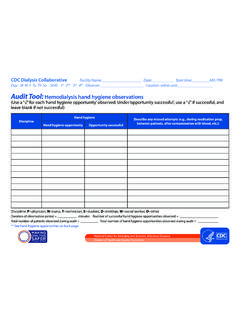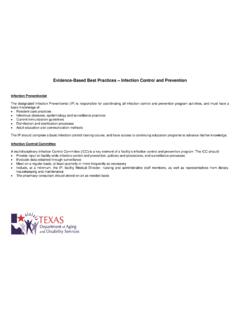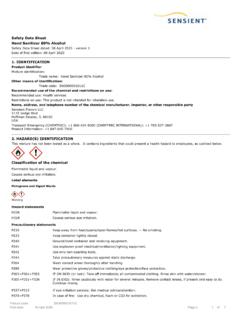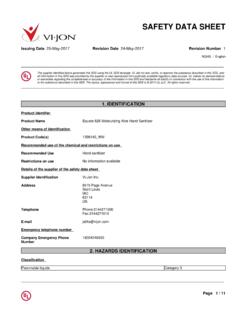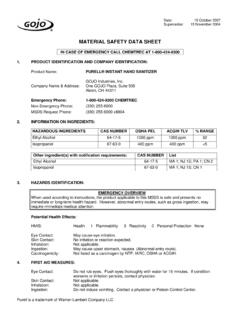Transcription of COVID-19 and Homelessness Services - Centers for Disease ...
1 COVID-19 and Homelessness Services Training for Homeless Shelter Workers Updated May 2021. Disclaimer This training includes content from interim guidance that is based on what is currently known about the transmission and severity of coronavirus Disease 2019 ( COVID-19 ) as of May 23, 2021. The US Centers for Disease Control and Prevention (CDC) will update this guidance as needed and as additional information becomes available. Please check the CDC website periodically for updated interim guidance and resources. Check here for resources specific to persons experiencing Homelessness . Learning objectives for homeless shelter workers Identify prevention and control strategies for coronavirus Disease 2019.
2 ( COVID-19 ). Discuss community approach to COVID-19 response Describe changes to your facility's layout and procedures Identify steps to screen people for possible symptoms of COVID-19 . Discuss considerations for unsheltered Homelessness Overview Background on COVID-19 Helping sick clients Planning and partnerships for Cleaning and disinfection homeless Services Considerations for unsheltered Changes to facility's layout and Homelessness procedures Reminders for staff protection Additional materials Background How COVID-19 is spread COVID-19 is an illness caused by a virus that can spread from person to person. You can become infected by breathing in air when close to an infected person who is exhaling small droplets and particles that contain the virus.
3 You can become infected when small respiratory droplets and particles that contain then virus land on the eyes, nose, or mouth, especially through splashes and sprays like a cough or sneeze. You may also be able to get it by touching eyes, nose, or mouth with hands that have the virus on them. Know the symptoms of COVID-19 *. Symptoms can range from mild (or no symptoms) to severe illness, and appear 2- 14 days after exposure to the virus that causes COVID-19 . Some individuals with COVID-19 lack symptoms (asymptomatic). Even those who eventually develop symptoms (pre-symptomatic) can transmit the virus to others before showing symptoms. *Does not include all possible symptoms.
4 Call a medical provider for any other symptoms that are severe or concerning to you. #studies Protecting yourself and others The best tools available for protection against COVID-19 are vaccination and appropriate non- pharmaceutical prevention measures. Everyone is at risk of getting COVID-19 . Older adults and people of any age who have serious underlying medical conditions may be at increased risk for severe illness. There are currently three different COVID-19 vaccines that have been authorized and recommended for preventing COVID-19 . Prevention basics Avoid close contact with others, including crowded public settings. Wear a mask over your nose and mouth any time you are not in their room or on a bed/mat in shared sleeping area.
5 Wash your hands often with soap and water for at least 20 seconds, or use hand sanitizer that contains at least 60% alcohol. Clean frequently touched surfaces daily. Do not touch your eyes, nose, or mouth. Planning and Partnerships for Homeless Services Finding guidance and other CDC resources CDC: COVID-19 /Guidance You can find guidance using the Guidance search tool. CDC: COVID-19 /Community, Work, and School /Homeless Populations Guidance for homeless populations and other types of group settings can be found in this section. Resources to support people experiencing Homelessness Resources to Support People Experiencing Homelessness FAQs, symptom screening tool for clients at homeless shelters, and helpful communication products.
6 Interim Guidance for Homeless Service Providers to Plan and Respond to Coronavirus Disease 2019 ( COVID-19 ). Web and PDF formats of the guidance are available. Information for state and local health departments is also available for responding to COVID-19 cases at homeless service provider sites. Interim Guidance on Unsheltered Homelessness and Coronavirus Disease 2019 ( COVID-19 ) for Homeless Service Providers and Local Officials Homeless Services Continuing homeless Services during community spread of COVID- 19 is critical. People experiencing Homelessness are at risk for infection during community spread of COVID-19 . Homeless shelters should not close or exclude people who are having symptoms or test positive for COVID-19 without a plan for where these clients can safely access Services and stay ( , identifying additional temporary housing and shelter sites).
7 Coordinate with local health authorities when making decisions about whether clients with mild illness due to suspected or confirmed COVID-19 should remain in a shelter or be directed to alternative housing sites. Community approach to COVID-19 response Connect with key partners on Homelessness to make sure that you can all easily communicate with each other while preparing for and responding to cases. A community coalition composed of key partners focused on COVID-19 planning and response should include: Local and state health departments Homeless service providers and Continuum of Care (CoC) leadership Emergency management Law enforcement Healthcare providers Housing authorities Local government leadership Other support Services like outreach, case management, and behavioral health support Additional sites needed during COVID-19 spread Community coalitions should identify additional temporary housing and shelter sites that can provide appropriate Services , supplies, and staffing.
8 Overflow sites to accommodate shelter decompression (to reduce crowding) and higher shelter demands Isolation sites for people who are confirmed to be positive for COVID-19 . Quarantine sites for people who are waiting to be tested or who know that they were exposed to COVID-19 . Protective housing for people who are at increased risk for severe COVID-19 . Additional sites Depending on resources and staff availability, consider individual rooms for the overflow, quarantine, and protective housing sites. , hotels, motels Provide linkages to respite (temporary) care for clients who were hospitalized with COVID-19 but have been discharged. Plan for how to connect clients to housing opportunities after they have completed their stay in these temporary sites.
9 Changes to Facility's Layout and Procedures Facility layout General Use physical barriers to protect staff who will interact with clients with unknown infection status ( , check-in staff). In meal service areas, create at least 6 feet of space between seats and/or allow food to be either delivered to clients or taken away by clients to eat at least 6 feet away from one another. In general sleeping areas (for those who are not experiencing respiratory symptoms), try to make sure clients' faces are at least 6. feet apart and align mats/beds so clients sleep head-to-toe. 6 ft 6 ft SLEEP HEAD-TO-TOE. Facility layout An area for clients with symptoms Prioritize individual rooms for clients with symptoms.
10 If individual rooms are not available, consider using a large, well-ventilated room for people with symptoms. Keep mats/beds at least 6 feet apart. Align mats/beds so clients sleep head-to-toe. Use temporary barriers between mats/beds, such as curtains. If possible, designate a separate bathroom for these clients. If suitable areas are not available in the facility, help transfer clients to a quarantine site until they can be tested. 6 ft 6 ft SLEEP HEAD-TO-TOE. Facility layout Clients with confirmed COVID-19 . Prioritize clients with confirmed COVID-19 for individual rooms. If more than one person has tested positive for COVID-19 , these clients can stay in the same area. Designate a separate bathroom for these clients.










